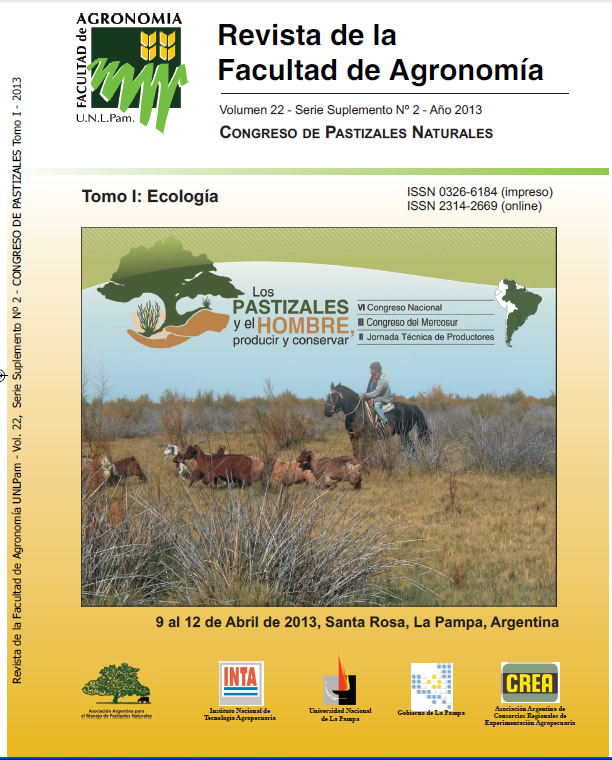Avaliação da diversidade funcional para atributos de plantas forrageiras de pastagem natural no Rio Grande do Sul
Palabras clave:
Atributos foliares, coeficiente de Rao, Indice de SimpsonResumen
Esse trabalho foi realizado com o intuito de avaliar a diversidade funcional medida pelo índice de Simpson e o coeficiente de Rao calculados com os atributos foliares, teor de matéria seca (TMS) e área foliar específica (AFE), avaliando se essa metodologia pode ser utilizada com a coleta apenas das espécies de maior contribuição à biomassa aérea. As coletas foram realizadas em área de pastagem natural, na região Central do Rio Grande do Sul, Brasil. A área experimental correspondia a 3,93 ha, dividida em potreiros, onde foram alocadas transectas em diferentes posições de relevo, sendo que algumas sofreram queima localizada. Foi avaliada a composição botânica em quatro períodos de pastejo, representativos da estação de crescimento (da primavera até o outono). As gramíneas majoritárias na massa de forragem, em cada avaliação, foram coletadas para determinação da AFE e do TMS. Esses atributos foram usados para o cálculo do índice de Simpson e do coeficiente de Rao da AFE, do TMS e da média da AFE/TMS com o auxilio da Excel Macro http://botanika.bf.jcu.cz/suspa/FunctDiv.php. Foi avaliada a correlação entre os índices nas diferentes coletas si e com o número de espécies por coleta e feitas análises de agrupamento e ordenação. O índice de Simpson e os índices de diversidade funcional, usando a AFE, o TMS e a média AFE/TMS possuem relação com o número de espécies. O número das espécies para o cálculo dos índices de Simpson e de Rao pode ser restrito às espécies majoritárias na massa de forragem.
Descargas
Citas
Boldrini I.L. 2009. A flora dos campos do Rio Grande do Sul. In: Campos Sulinos conservação e uso sustentável da biodiversidade (V.P. de Pillar, S.C. Müller Z.M.S. Castilhos & A.V.A. Jaques ed.). Ministério do Meio Ambiente, Brasília DF. pp. 63-77.
Garagorr F.C. 2008. Construção de uma tipologia funcional de gramíneas em pastagens naturais sob diferentes manejos. 176f. Dissertação Mestrado, Programa de Pós-Graduação em Zootecnia, Universidade Federal de Santa Maria, Santa Maria.
Leps J., F. Bello, S. Lavorel & S. Berman. 2006. Quantifying and interpreting functional diversity of natural communities: pratica considerations matter. Preslia 78: 481-501.
BOTANAL. 2007. In: IV Congresso Nacional sobre Manejo de Pastizales naturales e I Congreso del Mercosul sobre Manejo de Pastizales naturales, Vila Mercedes. Anais. Congreso Nacional Sobre Manejo de Pastizales Naturales. Vila Mercedes: Universidad Nacional de San Luis.
Tothill J.C., C.K. McDonald, R.M. JONES & J.N.G. 1992. Hargreaves. BOTANAL, A comprehensive sampling and computing procedure for estimating pasture yield and composition. 1. Field sampling. Trop. Agric. Tech. Memo. 78: 1-24.
Publicado
Número
Sección
Licencia
La Editorial de la Universidad Nacional de La Pampa (EdUNLPam) exigirá a los/as autores/as la firma del siguiente documento:
La EdUNLPam lleva a cabo la publicación del artículo: (Título del Artículo) en SEMIÁRIDA Rev.Fac.Agron UNLPam ISSN 2362-4337 (impresa) ISSN 2408-4077 (en línea), del cual el/los abajo firmantes son autores de una o más partes. En el mismo acto, el/los autores entregan exclusivamente a la EdUNLPam todos sus derechos protegidos por las leyes de propiedad intelectual que rigen en la Argentina para reproducir, publicar, editar, fijar, comunicar y transmitir públicamente en cualquier formato o medio impreso o electrónico, inclusive internet, el artículo enviado a publicación e incluirlo en índices o bases de datos nacionales e internacionales. A cambio, la EdUNLPam entrega a los autores la autorización para la publicación o reimpresión con ines académicos y educativos en cualquier libro o medio de divulgación, con la sola obligación de citar el artículo original publicado en la EdUNLPam. Cada autor acuerda en que el material provisto a la EdUNLPam es un trabajo original, que no ha sido impreso o publicado en cualquier otro medio con anterioridad y que no vulnera derechos de terceros. El Primer autor tendrá la posibilidad de leer y corregir el artículo ya editado como “prueba de galera”, pero si el autor no devolviera esas correcciones de la prueba de galera dentro del tiempo especificado, el proceso de producción y publicación podrá proseguir sin la aprobación del autor. El/los autor/es no recibirán compensación monetaria de la EdUNLPam por el uso del material contenido en este artículo y asumen la responsabilidad de las opiniones vertidas en él.






.png)



22.png)


.jpg)




.jpg)
10.png)



